Small Helicopters & Gyrocopters Circa 1992
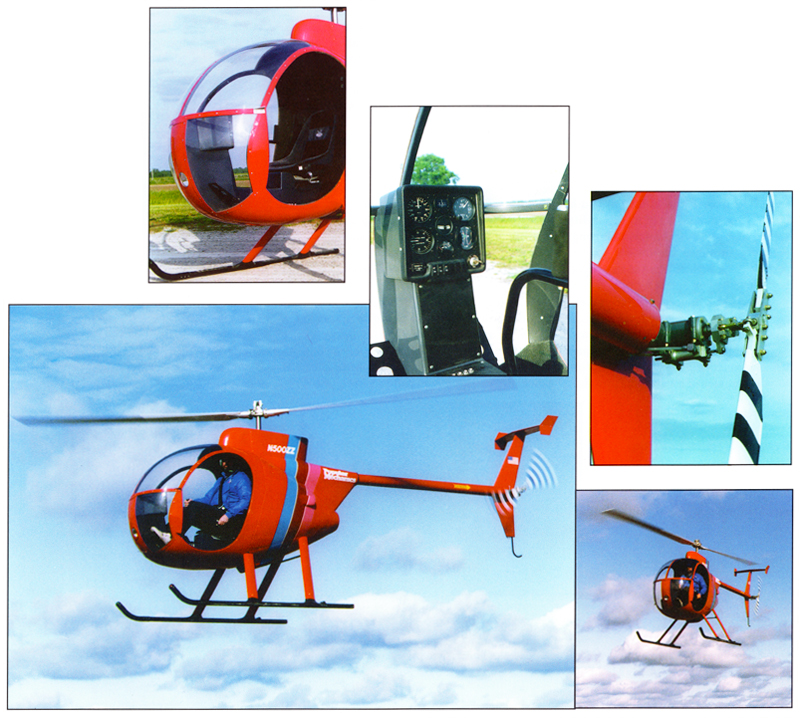
TOP LEFT: Large removable doors allow easy access to the completely finished, carpeted and upholstered cabin. The landing light and skid mounted navigation lights are standard equipment. Incredible visibility in all axis through the crystal clear windshield. The seat slides easily to accommodate almost any pilot. Plenty of elbow room, too!
TOP CENTER: The standard instrument panel comes complete with all instruments shown and has plenty of room for communication and navigational avionics. Electric starter, switches and breakers are included in the kit.
TOP RIGHT: All Drive train components, except the Rotax 582 engine, are built in-house by Revolution Helicopter Corp. The tail rotor gear box is shaft driven and uses helical cut gears. Easy to inspect, easy to maintain, simple and light, the components have a 2000 hourTBO. The tail rotor anti-torque control assembly can be easily removed for trailering.
DESIGNERS OF THE NEW BREED OF SMALL HELICOPTERS PROVIDED SPECTATORS WITH GREAT ROTOR ACTION AT OSHKOSH THIS YEAR
In 1990, Dennis Fetters had the only experimental small helicopters in operation at Oshkosh – the CH6, and throughout the week of the Festival, he treated spectators to many amazing demonstration flights in that rotorcraft which later became the CH7 Angel.
A well-known sport aviation figure, Dennis Fetters was the marketing power behind Air Command Manufacturing which produced the popular Air Command Gyroplane in many different configurations. As expected, Dennis was back at Oshkosh again this year, this time with his prototype model of the Revolution 500 kit helicopter, to be marketed as the Mini 500.
Evidenced by the photos sent to the news media prior to the show, Dennis Fetter’s Mini 500 had been flown several times (presumably at its home base) before being taken to Oshkosh. Why it didn’t fly at Oshkosh too, we never found out. It could have been because the amount of time required by the FAA before they will sign it off hadn’t yet been completely flown off – but that is only conjecture.
Dennis Fetter’s Revolution 500 was on display at the Ultralight and Rotary Wing area, but because it’s a few hours short of having its time flown off, It did not make any demonstration flights.
This year (1992), however, Dennis’ wasn’t the only kit helicopter around. The sky over Oshkosh was buzzing with true small helicopters of all different shapes and sizes — one of them even equipped with a true turbine engine. That turbine-powered flying chopper, which also flew last year, was the very nice single-place Predator helicopter model from Cobra Helicopters.
Turbines are known for their reliability and lack of engine vibration (and high fuel usage!), and Cobra Helicopters use some of the time-tested Helicom mechanics of many years ago whose dependability in the homebuilt field has been well demonstrated. In addition to the single-place Cobra which was flying throughout the week, Gary Helton of Cobra Helicopters also had a two-place turbine-powered Cobra on display.
Gary says he now has available a much larger surplus turbine engine, and this two-place version in which it will be installed should find a greater, wider number of uses than those of single-place small helicopter configuration.
The pilot from one gyrocopter manufacturing group based in Canada, RAF Gyroplanes, was burning holes in the pattern at Oshkosh with their little Subaru-powered gyroplane. It sure smoked right along with speed and agility.
Deserving extra-special mention here is the Rotorway Exec 90 helicopter kit from the people in Arizona. It won all the homebuilt helicopter awards at Oshkosh this year. This extremely well-designed, well-built deluxe two-place design is the benchmark of all homebuilt helicopters.
It was equipped with a well-proven 100+ hp four-stroke engine which appeared to me as though it might have been conceived from a Volkswagen, but all that the factory people will say is that it was built here, by them, with all newly-designed parts.
About a year ago, I was privileged to fly the Rotorway Exec 90 out there in Arizona for about two hours, and I liked it so much, they practically had to drag me out of the cockpit. It was one of my biggest thrills ever.
At that time, Rotorway advertised the Exec 90 at an “Introductory Price” of $39,000USD. By now, production costs may have caused the price of that aircraft to go up — somewhere in the neighborhood of $45,000, I believe.
Although this may seem high, the professionally-designed-and-built two-place Rotorway Exec 90, equipped with a reliable four-stroke engine, costs only slightly more than the little single-place Rotax-powered “Angel” from Italy (described below).
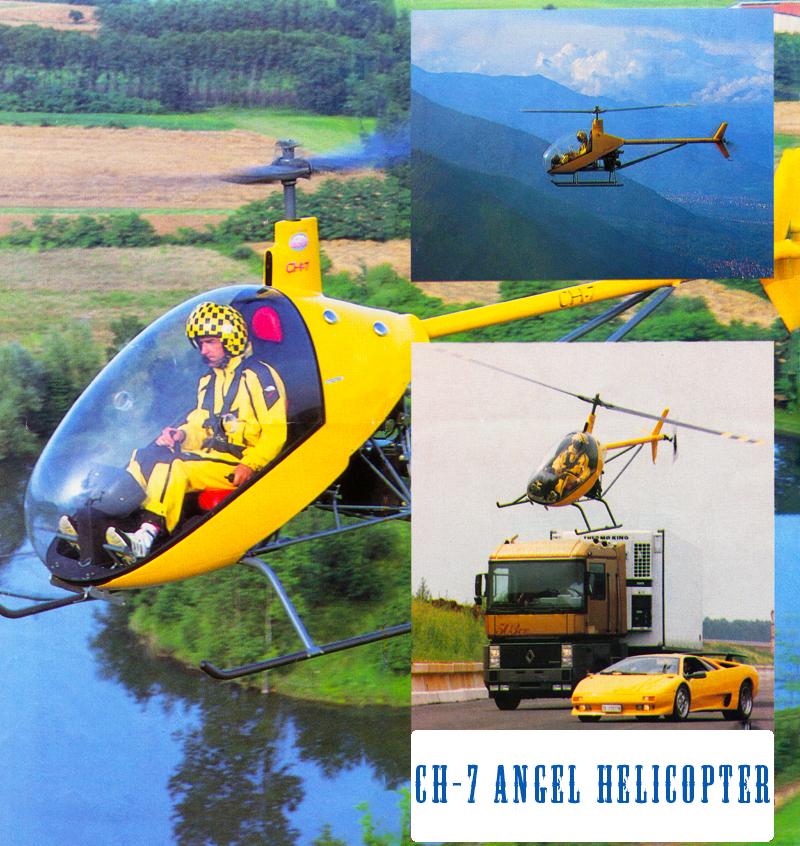
I’ll let the reader (and prospective customer) be the judge of which would be the better value for his dollar though can see the advanced technical aspects of the Angel CH7. The helicopter which Dennis Fetters flew at Oshkosh in 1990 was the precursor to the CH7 Angel known as the CH6 designed in Argentina by Augusto Cicare.
It was equipped with Augusto Cicare’s own patented new type of rotor head and swashplate control system of a revolutionary design. Using new techniques, the design eliminated the use of the large, heavy oscillating plate, thus greatly simplifying the control system in small helicopters.
Not only did this design solve many of the problems of traditional helicopter controls, it also simplified the manufacturing process, making construction far more economical. And because there were fewer parts, less maintenance was necessary. Since its inception, the system has been thoroughly tested in Argentina, Italy and the United States.
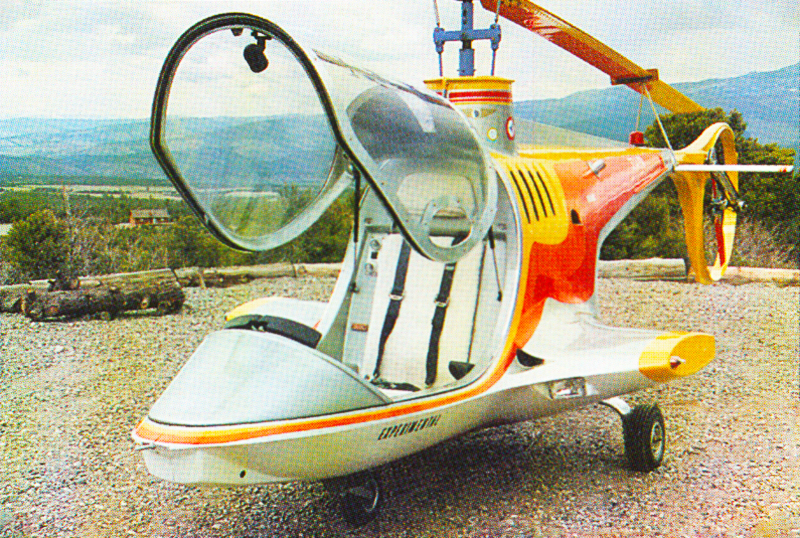
Single seat composite helicopter concept by Canadian Home Rotors
At some point in time, Dennis Fetters broke away from his business arrangement with Cicare – (while “borrowing” Augusto Cicare’s cyclic design), and started his own company to manufacture a miniature Hughes 500 look-alike powered with a Rotax 582 engine. It’s called the Revolution 500 or the Mini 500. (This is the one Dennis brought to Oshkosh this year.)
The helicopter which stole the show at this Oshkosh Convention was the new CH-7 “Angel” from Italy, with mechanics designed by Augusto Cicare, yes, the same genius Argentinean aircraft engineer. The helicopter itself was designed by Marcello Gandini and what a thing of beauty it is.
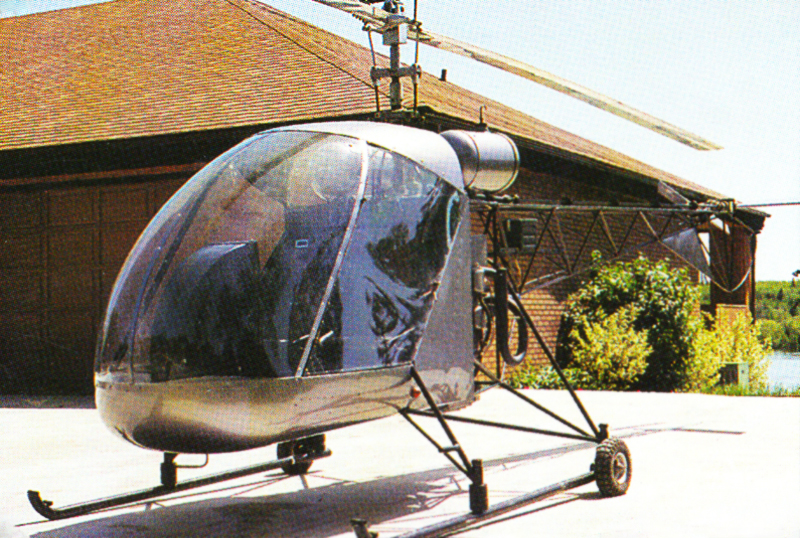
The Excel was designed and built in Canada for the emerging lightweight helicopter market. EDITOR: The Excel came before the Baby Belle and after the Commuter helicopters but used the same running gear.
During the entire week of the Oshkosh Festival, the little “Angel” spent so much time making demonstration flights, it seemed to be in the air all the time. The mechanics on this aircraft and the engine seem very similar to those of the Revolution Mini 500 though flying with superb agility.
If someone were to examine these two small helicopters, they would, at first glance, appear to be somewhat comparable. Both are attractive machines. One looks like a well-known full-scale helicopter; the other looks like the original prototype with a well-designed mini-fairing on it.
Both have the same engine, and what looks like the same mechanics. Quality of workmanship and quality control of parts will probably be one of the decisive factors to those choosing between the two. The other will undoubtedly be cost, but let me state the obvious “you get what you pay for”.
With a price tag of about $35,000, plus crating and shipping charges from Italy, the “Angel” could end up costing $40,000 by the time it reaches this country and your workshop. Dennis Fetters’ Mini 500, on the other hand, will only cost you half that much, plus a little more. Makes you think, doesn’t it.
EDITOR: (2017)…as we soon found out, the lower cost unfortunately reflected the little machines reliability resulting in no less than 10 fatalities to date….
We do wish all of the above companies the best of luck with their small helicopters because, from what I hear, there are plenty of customers for all kinds, sizes and types of helicopters out there now, and to some people, price is no object.
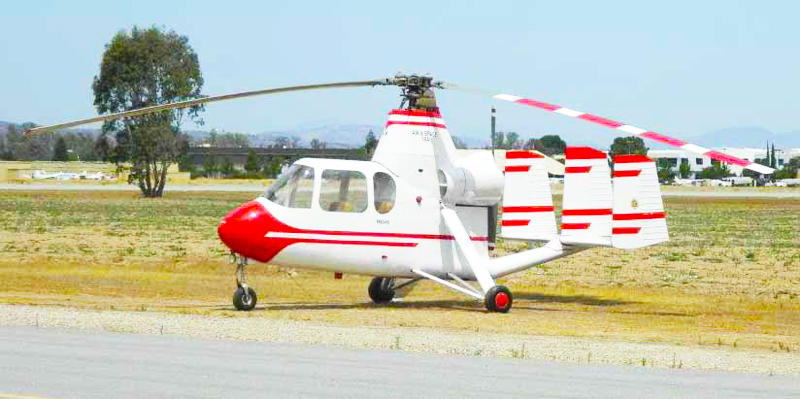
At Oshkosh this year, gyroplanes seemed to be taking a back seat to the products of new developments in the miniature helicopter field.
Actually, the gyroplane was originally developed as a substitute for the helicopter — a less expensive substitute, and one which was much easier to build and to fly. One of the problems with a gyrocopter is that, in most cases, it must be operated from a much longer runway than that needed for most ultralights and very light aircraft.
Other problems arose when gyroplanes were built in two-place configurations. In order to carry a passenger in a gyroplane, a pilot must have a Rotary Wing License for gyroplanes, and there are very few places in the US at this current time where such instruction and a check-out ride are offered.
The RAF gyroplanes made a return visit to Oshkosh this year and flew many demonstration flights with their fast, enclosed-cockpit gyroplanes.
Gyroplanes currently operate under the same rules as ultralights, and if the unit weighs more than 254 pounds and has two seats, it must be registered as a gyroplane, and a pilot must possess the correct license in order to fly it legally — either a Private License or a Student Permit with an Instructor’s Endorsement.
Not many gyroplane operators do. In fact, at a recent gyroplane fly-in held at El Mirage, I was conducting an interview with a well-known licensed gyroplane instructor. During the course of our conversation, she waved her hand toward the large number of aircraft assembled there and said in a matter-of-fact way: “Over 95 percent of these folks are flying illegally.”
Since the early 1920s, most of the gyroplanes which have been built, owned, and flown were purchased by people who couldn’t find or couldn’t afford a helicopter yet. With the advent of the relatively inexpensive homebuilt helicopters of today, the wait appears to be over though the more complex training regime begins!
“Relatively inexpensive” is a somewhat arbitrary term, however, because even homebuilt helicopters are not exactly cheap. Prices start in the mid-$20,000-dollar range, go up to the mid-$40,000s, and can rise far beyond that, of course.
For those homebuilders with limited finances who find even those figures beyond their reach, maybe it’s time to consider a gyroplane, because some can cost as little as $10,000 in kit form – less for plans built if you have the skills!
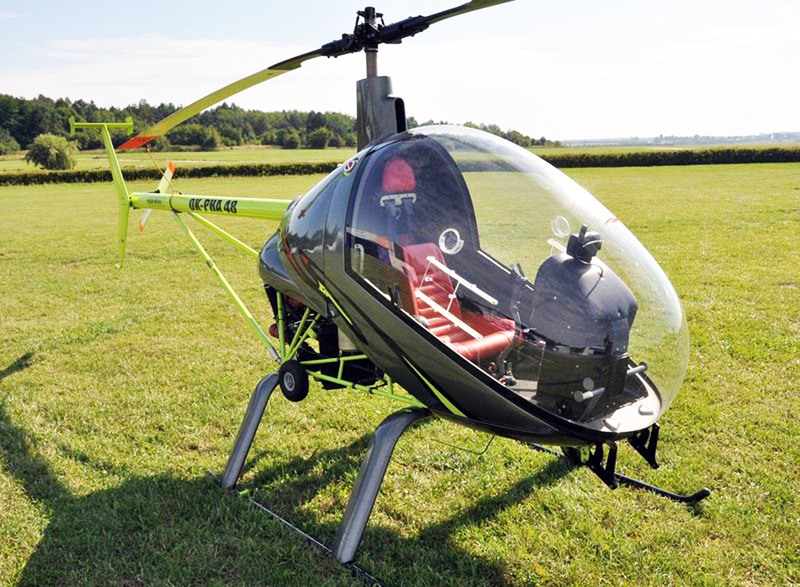
Many homebuilders who waited long years for the great helicopter expansion to occur may find that, now that it’s finally here, those choppers are still just too expensive, so the demand for gyroplanes might possibly be revived.
Most gyroplane designs haven’t changed much over the years. The people in Florida who purchased the rights to Air Command’s gyroplane were at Oshkosh, or had dealers who were, but their aircraft is unchanged also, except for some minor cosmetic improvements.
In reality, very little at all has changed in gyroplane design since the days of Igor Bensen’s gyro copter. You may have noticed I only used the term “gyrocopter” when I referred to Igor Bensen’s aircraft, and that’s because he not only had his invention patented, Igor also had the word “gyrocopter” copyrighted. There is still much room for improvements.
As for flying helicopters, the rules for flying a single-place helicopter state that the pilot must be signed off by a helicopter instructor and that he must have a Student Permit. If the helicopter weighs less than 254 pounds, it may be flown without a license, since it qualifies as an ultralight, and falls under those rules.
If you build a two-place helicopter and fly it solo, and intend to take a passenger with you, you must have a helicopter Private Pilot’s License, and the airplane must be registered as Experimental.
The people at Rotorway of Arizona have a program in place where they will teach a customer to fly in one of their aircraft, but only under a special wording on the purchase contract. Also restricting any parts purchases to registered owners of their ships.
That’s because the FAA says you may not use homebuilt aircraft for commercial purposes, and teaching somebody to fly in an aircraft which doesn’t belong to the student pilot is not allowed. Yes, gyroplanes and helicopters have always fascinated the non-flying public, but it often comes as quite a shock to them that to learn to fly or to purchase one is quite expensive.
This shouldn’t really come as a surprise because, by their very nature, helicopters must be scientifically designed, superbly constructed of only the very best materials, and meticulously maintained, and all this costs quite a bit of money.
It’s all worth it though, because from my own personal experience, I can honestly say that nothing quite compares with the unique excitement, the fun and the thrill of flying a rotor-wing aircraft — a real helicopter! Don’t miss it.
Promotional Brochure From Canadian Home Rotors
We offer complete and courteous support to anyone interested in small helicopters of every make. Skeptical? Ask our builders in your area. Sign up for our FREE Newsletter which will keep you up-to-date on the happenings with Canadian Home Rotors and the helicopter market.
Our builders get an additional Newsletter to keep them informed with all aspects of safety, construction, maintenance and piloting. We care, making us the best choice. EDITOR: Note this was pre-email!
Building a safe, useful and reliable helicopter with Canadian Home Rotors Inc. is a rewarding experience
Quality components are machined to the highest aircraft standards with pride given to the smallest detail. The BABY BELLE components have been perfected during 12 years of development.
We use a LYCOMING aircraft engine powering geared transmissions and driveshafts to give true dependability and low maintenance. All machined parts are anodized or plated for complete corrosion protection. You can be assured that only high quality aircraft materials and hardware are used. The BABY BELLE can accommodate most customer’s requirements.
Baby Belle Features:
-
Clear Construction Prints
-
Detailed Manuals
-
Free Builders Newsletter
-
Lycoming Aircraft Engine
-
Dual Ignition Standard
-
Air Cooled Engine
-
All Gear Driven
-
Corrosion Protected
-
Aircraft Quality
-
Personal Body Designs Possible
-
Driveshaft Driven
-
Auto Clutch Engagement
-
Carb & Cabin Heat
-
Excellent Autorotation
-
Dual Controls are Standard
-
4130 Chromemoly Tubing
-
Rugged Design
-
No Belts
-
No Chains
-
Stainless Steel Tailrotor Blades
Promotional Brochure From Elisports Small Helicopters
HISTORY
Augusto Cicare after 35 years in helicopters design in 1987 searching for an economical model creates the CH-6 that in the evolutionary version CH-7 is destined to discredit the helicopter myth thanks to the pilotage simplified by the reduction of rotor’s moving parts economical, reliable and easy to fly and to maintain.
Patent n° 91307
Marcello Gandini famous designer, author of many successful projects such as “AM MAGNUM RENAULT TRUCK” of the year ’91 and the fabulous Lamborghini “COUNTACH” and “DIABLO” signs today “ANGEL” CH-7 the revolutionary one-seat helicopter.
CH7 ANGEL PERFORMANCE SPECIFICATIONS
-
TYPE: Ultralight helicopter, ONE-SEAT
-
ENGINE: 600 cc, 65 horsepower, two cycle, two cylinder, dual ignitions, liquid cooled
-
UTILIZATION: Transport, tourism, agricultural activity
-
STRUCTURE: Steel trestle weld and aluminium tubes bolted
-
TRANSMISSION SYSTEM: cardanic gear and transmission box oversize for higher security
-
CONTROL SYSTEM: “PULL-PUSH” without cables
-
INSTRUMENT PANEL: Air-speed meter, altimeter, rotor-engine revolution indicator, engine temperature, hour counter.
| SPECIFICATIONS | U.S.A. | EUROPE |
|---|---|---|
| LENGHT | 23 FT | 7.15 m |
| HEIGHT | 81 INCHES | 2.08 m |
| WIDTH | 62 INCHES | 1.60 m |
| MAIN ROTOR DIAMETER | 19 FT | 6 m |
| TAIL ROTOR DIAMETER | 40 INCHES | 1.03 m |
| EMPTY WEIGHT | 374 lbs | 170 kg |
| USEFUL LOAD | 308 lbs | 140 kg |
| MAX SPEED | 86 mph | 140 km/h |
| CRUISE SPEED | 68 mph | 110 Km/h |
| VERTICAL SPEED | 1200 FPM | 7 mt/s |
| RANGE MAX | 3 h 205-SM | 3 h – 330 Km |
| FUEL CAPACITY | 10 gal. | 40 lt. |
| HOVER IN-GROUND EFFECT | 7,000 FT | 2,100 m |
| HOVER OUT-OF-GROUND EFFECT | 5,000 FT | 1,500 m |
| SERVICE CEILING | 11,000 FT | 3,500 m |
Project: Augusto Cicare
Cabin and blades: Designed and produced by Marcello Gandini
Helicopter production: Elisport
Dealer: Aerosport
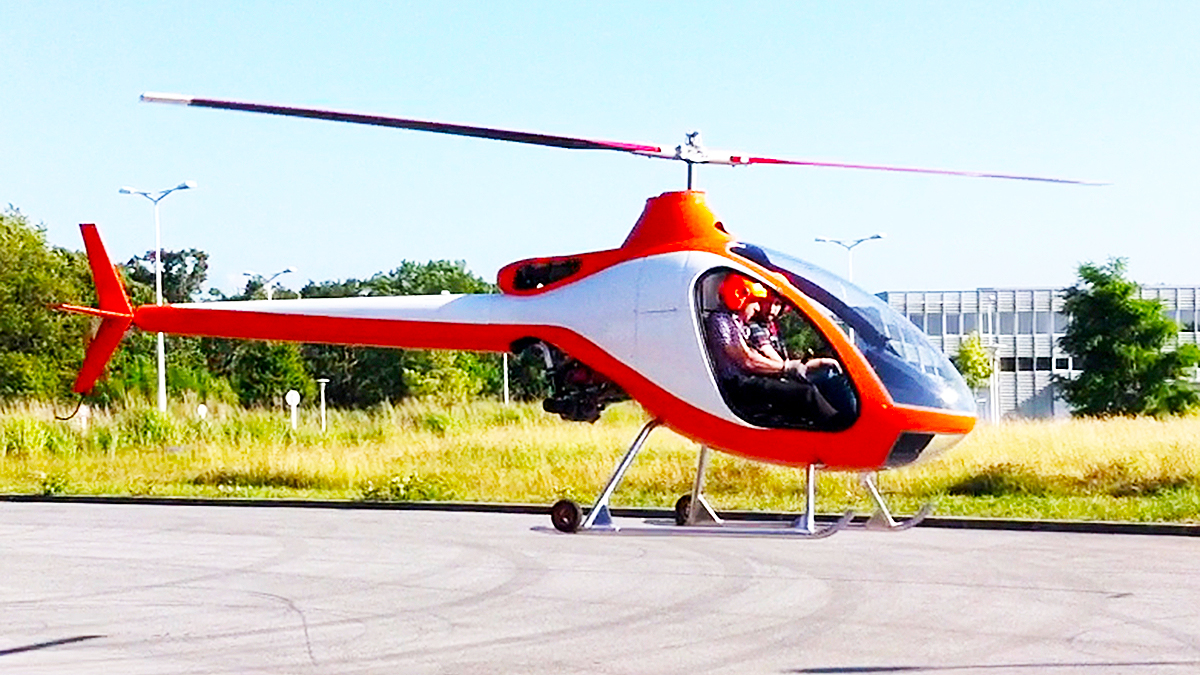


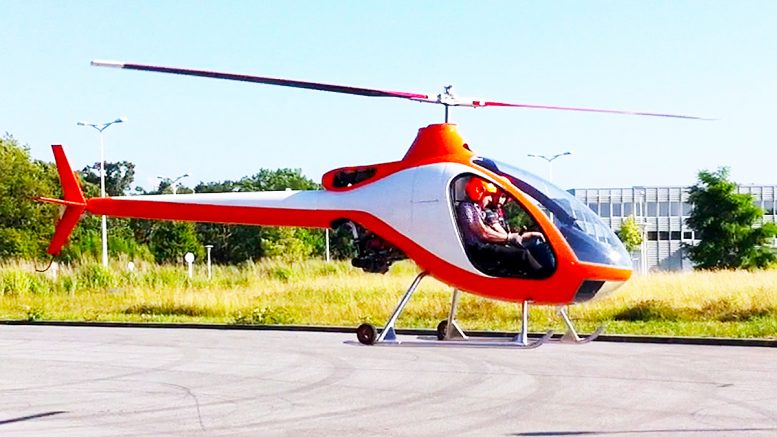
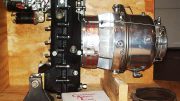
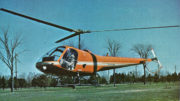
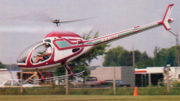
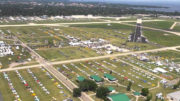
Be the first to comment on "The New Breed Of Small Helicopters (1992)"